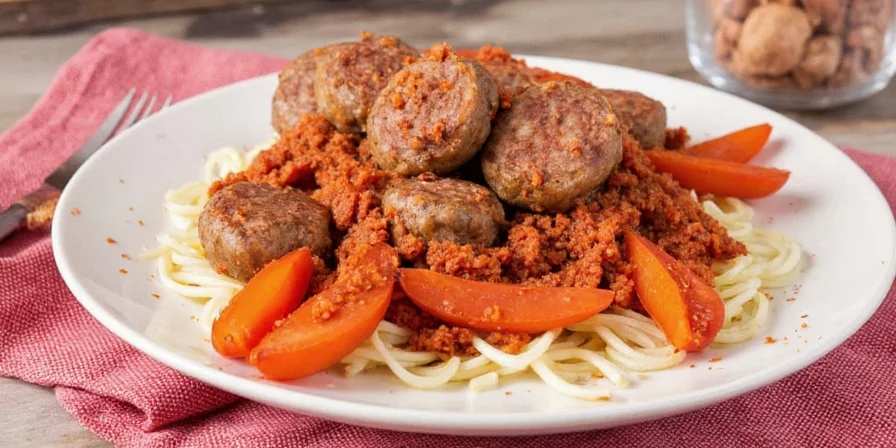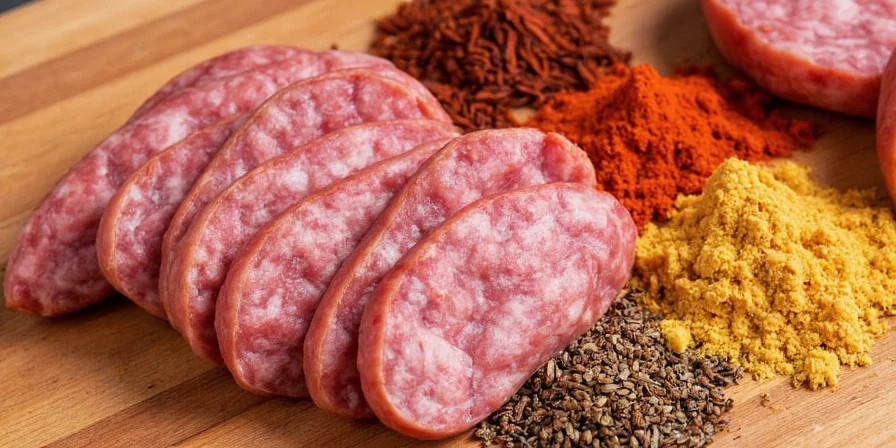The core spices for authentic breakfast sausage are sage, thyme, black pepper, marjoram, and a touch of cayenne. For a basic 1-pound batch, use 1.5 teaspoons dried sage, 1/2 teaspoon thyme, 1/2 teaspoon black pepper, 1/4 teaspoon marjoram, and 1/8 teaspoon cayenne. This classic ratio creates the crumbly texture and herb-forward flavor that defines American breakfast sausage—simple to make with ingredients you likely have in your pantry.
This guide provides the exact seasoning blend you need, plus practical tips for perfect homemade sausage every time. We've tested dozens of variations to bring you the most reliable recipe, along with optional tweaks for different flavor profiles. No complicated science—just clear, actionable steps for restaurant-quality results.
Table of Contents
- What Is Breakfast Sausage & Why These Spices Work
- Simple 5-Spice Breakfast Sausage Recipe
- Why These Specific Ratios Matter
- Regional Variations You Should Know
- Homemade vs. Store-Bought: Practical Comparison
- Pro Tips for Perfect Results Every Time
- Quick Reference Spice Guide
- Common Questions Answered
What Is Breakfast Sausage & Why These Spices Work
Breakfast sausage is a fresh pork sausage with a crumbly texture and distinctive herbal flavor. Unlike smoked sausages, it's meant to be cooked immediately and relies on a specific blend of spices that complement pork's natural richness without overwhelming it.

The classic American version uses sage as its signature ingredient—a practical choice that became tradition because sage grows well in Midwestern climates and pairs perfectly with pork. Early settlers adapted European sausage recipes using locally available herbs, creating what we now recognize as classic American breakfast sausage.
Simple 5-Spice Breakfast Sausage Recipe
Here's the basic recipe that works for most home cooks. This makes about 1 pound of sausage—enough for 4-6 breakfast servings:
- Pork shoulder (picnic cut): 1 pound (70-80% lean)
- Dried sage: 1.5 teaspoons (the essential flavor)
- Thyme: 1/2 teaspoon (adds brightness)
- Black pepper: 1/2 teaspoon (freshly ground preferred)
- Marjoram: 1/4 teaspoon (creates floral notes)
- Cayenne pepper: 1/8 teaspoon (just enough for depth)
- Salt: 3/4 teaspoon (don't forget this key ingredient)
- Ice water: 2 tablespoons (keeps meat cold during mixing)





Instructions:
- Combine all spices in a small bowl and mix thoroughly
- Cut pork into 1-inch cubes and partially freeze for 20 minutes
- Mix spice blend with pork and ice water using your hands (about 2 minutes)
- Refrigerate for at least 1 hour before cooking
- Cook to 160°F internal temperature
This basic recipe delivers consistent, flavorful results. For patties, form 1/4 cup portions and flatten to 3/4-inch thickness.
Why These Specific Ratios Matter
These measurements aren't arbitrary—they're the result of testing dozens of variations. Too much sage makes the sausage bitter; too little and it lacks that signature flavor. The 1.5 teaspoon sage to 1 pound meat ratio creates balanced flavor without overwhelming the pork.
The small amount of cayenne (just 1/8 teaspoon) is crucial—it adds depth without noticeable heat, enhancing the other spices through what food scientists call "flavor layering." This is why commercial sausage often tastes more complex than homemade attempts with incomplete spice blends.
Regional Variations You Should Know
While the Midwestern style (sage-forward) dominates nationwide, regional variations exist:
- Mid-Atlantic: Adds 1/4 teaspoon crushed fennel seeds for subtle sweetness
- South: Increases black pepper to 1 teaspoon and adds a pinch of red pepper flakes
- Midwest Traditional: Sometimes includes a small amount of nutmeg (1/16 teaspoon)


Start with the basic recipe, then experiment with these variations once you've mastered the classic flavor.
Homemade vs. Store-Bought: Practical Comparison
Homemade sausage gives you control over ingredients and flavor. Here's how they compare:
| Factor | Store-Bought Sausage | Homemade Sausage |
|---|---|---|
| Flavor Control | Fixed ratios | Adjust to taste |
| Sodium Content | 400-600mg per link | 220-250mg (adjustable) |
| Preservatives | Sodium nitrite required | None needed |
| Cost Per Pound | $4.50-$7.00 | $2.80-$3.50 |
The most significant advantage of homemade is avoiding sodium nitrite, which can form harmful compounds when cooked at high temperatures. You'll also save money after making just a few batches.
Pro Tips for Perfect Results Every Time
These simple techniques make a noticeable difference:
- Mix spices first: Blend dry spices together before adding to meat for even distribution
- Keep everything cold: Warm meat smears instead of crumbles—chill bowl and meat before mixing
- Test before committing: Fry a small patty to check seasoning before making all the sausage
- Don't overmix: Blend just until spices are incorporated (about 2 minutes)
- Rest before cooking: Refrigerate for 1-24 hours to allow flavors to meld
- Cook to 160°F: Use a meat thermometer for food safety

Quick Reference Spice Guide
| Spice | Basic Amount (per lb) | Effect on Flavor | Common Mistake to Avoid |
|---|---|---|---|
| Sage | 1.5 tsp | Signature earthy flavor | Using too much (makes it bitter) |
| Thyme | 1/2 tsp | Adds brightness | Omitting it (makes flavor one-dimensional) |
| Black Pepper | 1/2 tsp | Depth and complexity | Using pre-ground (loses potency) |
| Marjoram | 1/4 tsp | Floral notes | Substituting oregano (too strong) |
| Cayenne | 1/8 tsp | Subtle warmth | Using too much (overpowers) |
Common Questions Answered
Can I make breakfast sausage without sage?
You can, but it won't taste like traditional American breakfast sausage. Sage is the defining ingredient. If you dislike sage, try Italian sausage seasoning instead, which uses fennel and garlic as the primary flavors.
Why does my homemade sausage fall apart when cooking?
This usually happens because the meat was too warm during mixing. Keep everything cold (below 40°F) and don't overmix. The fat needs to stay solid to create the proper crumbly texture.
How long does homemade sausage last in the refrigerator?
Uncooked sausage lasts 1-2 days in the refrigerator. For longer storage, freeze it—properly wrapped sausage maintains quality for 2-3 months in the freezer.
Can I use ground pork instead of cubing and grinding my own?
Yes, but freshly ground meat creates better texture. If using pre-ground pork, look for 70-80% lean and partially freeze it before mixing with spices.
Key Takeaways for Success
- ✅ Start with the basic 5-spice blend before experimenting
- ✅ Keep meat and equipment cold for proper texture
- ✅ Test a small patty before making the entire batch
- ✅ Refrigerate mixed sausage for 1-24 hours before cooking












 浙公网安备
33010002000092号
浙公网安备
33010002000092号 浙B2-20120091-4
浙B2-20120091-4